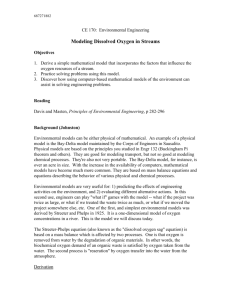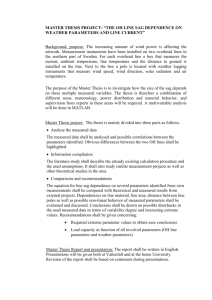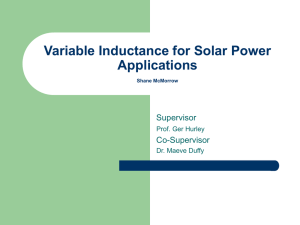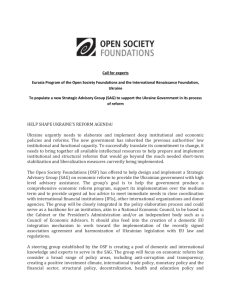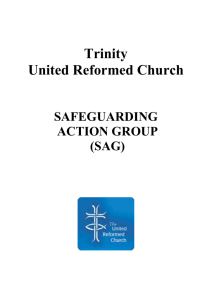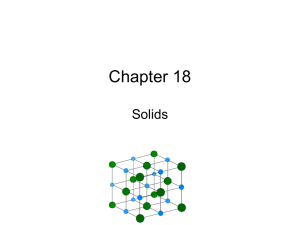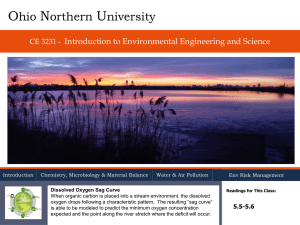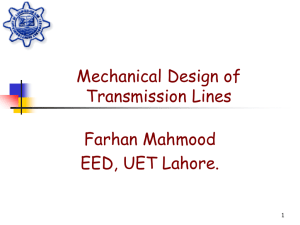CITY OF TORONTO: LONG-TERM WASTE MANAGEMENT
advertisement
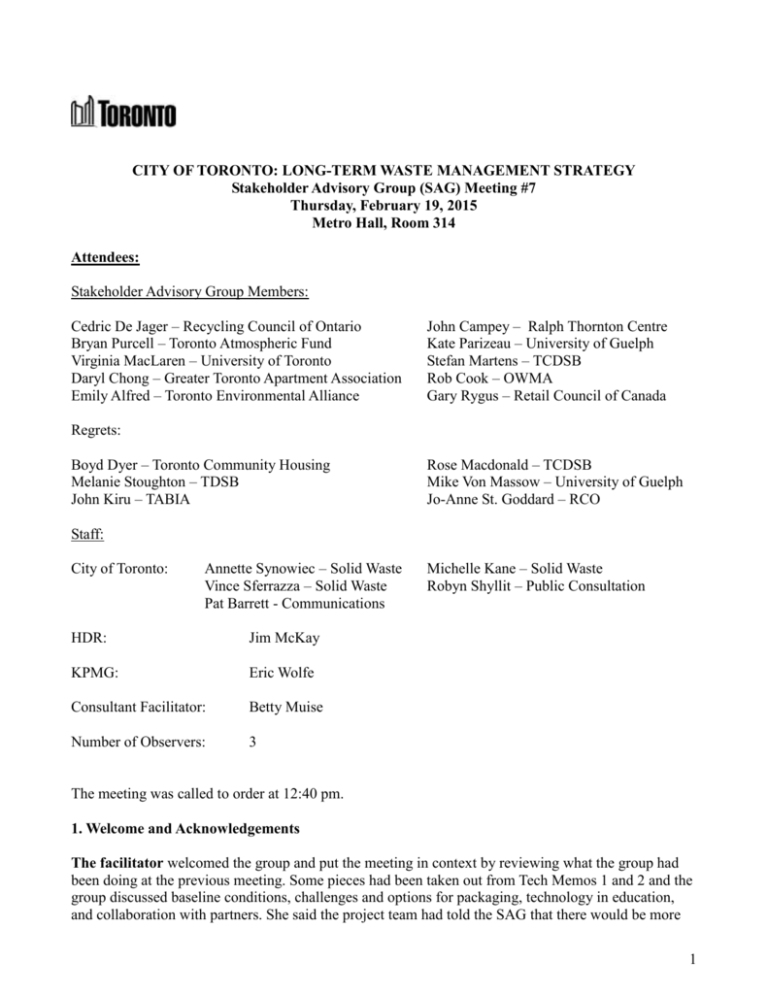
CITY OF TORONTO: LONG-TERM WASTE MANAGEMENT STRATEGY Stakeholder Advisory Group (SAG) Meeting #7 Thursday, February 19, 2015 Metro Hall, Room 314 Attendees: Stakeholder Advisory Group Members: Cedric De Jager – Recycling Council of Ontario Bryan Purcell – Toronto Atmospheric Fund Virginia MacLaren – University of Toronto Daryl Chong – Greater Toronto Apartment Association Emily Alfred – Toronto Environmental Alliance John Campey – Ralph Thornton Centre Kate Parizeau – University of Guelph Stefan Martens – TCDSB Rob Cook – OWMA Gary Rygus – Retail Council of Canada Regrets: Boyd Dyer – Toronto Community Housing Melanie Stoughton – TDSB John Kiru – TABIA Rose Macdonald – TCDSB Mike Von Massow – University of Guelph Jo-Anne St. Goddard – RCO Staff: City of Toronto: Annette Synowiec – Solid Waste Vince Sferrazza – Solid Waste Pat Barrett - Communications HDR: Jim McKay KPMG: Eric Wolfe Consultant Facilitator: Betty Muise Number of Observers: 3 Michelle Kane – Solid Waste Robyn Shyllit – Public Consultation The meeting was called to order at 12:40 pm. 1. Welcome and Acknowledgements The facilitator welcomed the group and put the meeting in context by reviewing what the group had been doing at the previous meeting. Some pieces had been taken out from Tech Memos 1 and 2 and the group discussed baseline conditions, challenges and options for packaging, technology in education, and collaboration with partners. She said the project team had told the SAG that there would be more 1 discussion on the 3Rs, and there will, but it would not be at this meeting. Rather, at this meeting, the focus would be on baseline conditions, challenges and opportunities related to collection, transfer of waste, and financing of solid waste management services. The facilitator reviewed the goal of the meeting which was to “discuss baseline conditions, challenges, and opportunities related to collection and transfer of waste and financing of SWMS to be considered for the Strategy”. Specific objectives include: Present the baseline conditions for preliminary Collection, Transfer and Financing options Discuss challenges & opportunities with collection and transfer identified to date. The facilitator reviewed the meeting's agenda. Annette Synowiec introduced Robyn Shyllit, who is the new Public Consultation Coordinator for this group. 2. Collection Jim McKay presented on Collection. The presentation content for this section are in Slides 5-13 in Appendix I. The following is a summary and captures discussion surrounding the presentation. Slide titles are underlined. Baseline Conditions – Single-family: Curbside collection of waste, recycling, and organics is semiautomated. It is a volume-based system that allows residents the option of setting out additional bags for a fee. Collection is set up to pay for the system, which is different than in many other Ontario municipalities. The City is responsible for collection. Some parts of Toronto have City crews doing collection, others have private contractors doing collection on behalf of the City. Baseline Conditions – Multi-residential: This is similar to the system for single-family homes, although the waste is collected from dumpsters by front-end loader vehicles. The biggest difference is that multiresidential buildings may opt out of City service and go to private service providers. Baseline Conditions – Other Customers: The City collects from many other types of customers too, including commercial businesses, charities, institutions, school boards, among others. A SAG member asked what the Yellow Bag Program is. Annette Synowiec said that it is a commercial user-pay system for small commercial locations that are typically along main streets. It was rolled out in 2002. They are required to buy yellow bags, and now there is an option to buy bins. Essentially it is a bag-tag system. Challenges: The City collection system faces several challenges, including: lack of awareness about some programs by users; the system makes it easier to put items at the curb versus reuse; management of waste not collected at the curb (when drop-off depots are typically designed for items to be dropped off by car, and an increasing proportion of Toronto's population is living in high density areas and do not have ready access to a car); costs; problems with the design of older multi-residential buildings; and collection container capacity (leading to overflowing bins and operational challenges). 2 Opportunities: Opportunities include underground collection, community environmental centres/public drop-off areas, modifications or removal of current programs being addressed by others (new businesses being set up to collect scrap metal put out at the curb replacing City collection), partnerships with industry or charitable organizations that collect items from the door, and provision of new and additional bins, including reverse-vending machines. The facilitator asked the group what other challenges, opportunities or issues they saw relating to collection. A SAG member said the City's built form is changing. It is getting denser and design preferences are changing, as reflected in the Official Plan. Efforts are being made to create more softscape rather than hardscape. He said that might need to be taken into account in the design of the appropriate form of collection, especially in neighbourhoods that are undergoing rapid change. Those areas may need different strategies. Another SAG member wondered about collection for reuse. Jim McKay said that some organizations, like the Canadian Diabetes Association (CDA), are already doing that for things like textiles. He said that it may be worth looking at opportunities for other items, perhaps like furniture. Annette Synowiec said that historically the City did a pilot program collecting furniture for reuse, but found that many materials were already damaged by the time the City got there for collection, rendering them unfit for reuse markets. The SAG member said she suspected another challenge would be that neighbours may well pick up the items for re-use before the City got there. Another SAG member added that other organizations like Furniture Bank also do this, and that could be both a challenge and an opportunity. Another SAG member said she thought the move toward privatization of collection would be worth discussing, since it touches on issues of values and efficiency. There is competing information about the efficiency of this system and it is also political. She thought it would be worth talking about as more than a technocratic decision. Vince Sferrazza said that contracting out was not included in the scope of the Long Term Strategy. That said, staff is preparing a report for Committee and Council in the Spring about contracting out collection services east of Yonge Street. It will attempt to address not just the cost, but perceptions of value-added service. At the moment collection is contracted out west of Yonge Street and for the multi-residential sector. This group could have that discussion, but it is not actually in the scope of the project, and there is no intention as part of this project to report back on the benefits, or lack thereof, of contracting out collection. Jim McKay added that since this is a 30-50 year strategy, the idea is to set the framework for what the system looks like – i.e. what services are provided, not necessarily the nuances of how they are provided. Vince Sferrazza expanded on that saying the same programs and services are provided east and west of Yonge St. The service levels have to be the same across the City. Another SAG member said that with regard to the private scrap metal collectors, there are some questions about the regulation of that service. For example, he wondered if they are taking appropriate health and safety measures. The question of who is doing the work can relate to the quality of work when it comes to informal vs formalized, regulated services. There are questions of what the City can do to keep that area within its purview or letting it drift out. A SAG member asked if the waste collection problems associated with multi-residential building design is a legacy challenge, or if it will continue to be a challenge going forward. Jim McKay said that Toronto has a standard that now incorporates recycling and organics collection into building 3 design. He noted that this is pretty progressive for an urban area. With the old buildings there is a legacy problem of not having enough space. With multi-residential, there is also the issue of public awareness, that requires constantly having to educate and re-educate new residents moving in, and addressing language barriers etc. Another SAG member added that the legacy buildings have single chutes, and often not enough space for separated waste streams. A SAG member wondered whether there are opportunities for partnerships for informal collection. She wondered whether that should be tackled head on, or whether to “sit back and let it happen”. Another SAG member said the success of take-back programs should be considered, which partly supports the informal sector and is a non-City way of encouraging people to bring items back for re-use. Another SAG member asked if blue box scavenging is less common now with the bins, rather than boxes. Annette Synowiec said there still is some scavenging for LCBO items. She didn't know if it has decreased for other items that don't have a deposit. Vince Sferrazza said that the City still sees scavenging with electronics, but they don't have a study of the other streams. The SAG member said that in other municipalities there is scavenging of aluminum products, because they can make money. Another SAG member suggested a more retail approach to the concept of drop-off depots, in which smaller depots would be located closer together. Another SAG member asked if there a possibility of having a collection depot somewhere on the transit system. The first SAG member suggested also having some located at, and in partnership with, retailers. Jim McKay said he thought it was a great idea to put them where the people are. Another SAG member suggested waste collection vehicles could be moved to natural gas fleets to reduce greenhouse gas (GHG) emissions. Another SAG member said there should be a serious look at in-ground containers to facilitate the kind of smaller, localized collection points being discussed before. This type of collection may be suitable for areas where there is not a lot of space above ground. Before, in-groundcollection was crane operated; now some are front-end operated, where a regular front-end truck could empty it. This may be a game changer for use in denser areas. Vince Sferrazza noted this would allow their use with existing trucks. Another SAG member suggested that the new communal Canada Post mailboxes may provide opportunities for drop off sites for certain types of items like batteries. Another SAG member said she thought the suggestion of the in-ground containers would be especially pertinent to collection in the public sphere. Public street bins are often overflowing and she anticipated that increasing density would continue to make this a bigger challenge. 3. Transfer Jim McKay presented on Transfer. The presentation content for this section are in Slides 14-18 in Appendix I. The following is a summary and captures discussion surrounding the presentation. Slide titles are underlined. He started by providing a definition of transfer. After materials are collected from customers, in some 4 cases the material is taken directly to a facility that processes that material. Usually, however, it is first taken to a transfer station where the materials are dumped onto a floor and then consolidated into larger loads before being taken longer distances to the processing facility. Essentially, it is more cost effective to take fewer but larger loads of materials to the processing facility. Baseline Conditions: The City owns and operates 7 transfer stations that are intentionally scattered geographically throughout the City. Challenges: As development in the City increases, so does pressure on transfer stations. They have been designed to serve a defined geographic area, but as those areas become more densely developed, the amount of materials collected increases dramatically. This is especially the case for the Commissioner Street Transfer Station in the Portlands, which is located in the area slated for redevelopment. This redevelopment also raises the issue of how drop off wastes will be handled as it will become an increasingly dense area with less car use and more emphasis on public transit. Another challenge is that the mixing of commercial and public traffic at Transfer Stations creates safety hazards. Transfer stations were designed for commercial vehicles, not private cars. Opportunities: Redevelopment provides an opportunity for new facilities to separate commercial and public traffic and to provide community recycling centres. A SAG member asked why the City takes commercial waste through their transfer stations, given that there are forty private transfer stations in Toronto. Jim McKay said that it is subject to market fluctuations. He said it could it be restricted in the future so that only City of Toronto materials are being managed at those facilities. The SAG member said that if the City wants Green Lane to last as long as possible, he didn't see why it would take IC&I waste. Vince Sferrazza said this point is worthy of review. If the City would ban receiving commercial waste, would there be sufficient capacity at the forty transfer station to absorb that material? He said he finds it interesting because the City is more expensive than the private facilities. The City raised its rates in the last two years, expecting commercial drop-off to decrease, but it actually increased. The SAG member wondered whether it was because of convenience. Annette Synowiec said she thought it was also a matter of familiarity for customers. Vince Sferrazza asked what kind of response the City would get from the private sector, and OWMA specifically, if they disallowed IC&I waste at City Transfer Stations. that. City Transfer Stations are designed to received the City's own trucks and to get vehicles in and out quickly. A SAG member said that transfer stations are relatively new in the waste management system. 30-50 years ago, these transfer stations didn't exist. They were built because the processing facilities became far away. The challenge for this group is to think about what this will look like in 30 or 40 years. It depends what the processing facility is and where it's located. Jim McKay agreed and said that Peel will be decommissioning its transfer station because they are building an Energy from Waste (EfW) facility and can do direct hauling. He also raised the point that with forty private transfer stations, the City could look at whether they need to replace the Commissioner Street station, or whether there is an opportunity to form a partnership to arrange waste to be shipped to some of private transfer stations. A SAG member said that although it is good to consider whether transfer stations will be needed in 30 years, in the meantime there should be consideration about whether the City should continue to accept IC&I waste. She asked whether that would extend to curbside collection of IC&I waste by the City. Another SAG member said that there are probably different criteria. There are specific criteria about 5 who qualifies for the Yellow Bag program, and the City refers those who don't qualify to private contractors. It could be a matter of the size of a business. Ultimately, he thought it could be done with the Yellow Bag program but it would be different criteria. The facilitator asked staff where discussion of IC&I would fit in the scope of the Strategy. Jim McKay said that the role of the City in managing IC&I fits in many different areas of the Strategy – extending the life of Green Lane, the need for transfer stations, the role of collection, and the revenue stream fits into the financial part of it. For each piece of the system, the Strategy will have to address what would happen if IC&I is in or out. Just as single-family and multi-family are looked at very differently, this is the third piece that has to be looked at separately. The facilitator asked whether IC&I will be addressed. Would it be under the topic of capacity, or is that decision precipitated separately and that would impact capacity? Jim McKay said that once the vision and guiding principles for the Long Term Strategy have been finalized, that will set the framework for how it will be addressed. The facilitator checked if the group members were satisfied to come back to it periodically, and generally they were. A SAG member asked what IC&I diversion is like. He said that if the City takes IC&I waste to landfill and it is full of recyclables, that is a problem. Another SAG member said diversion is very low, and the best guess is that it is around 11%. The first SAG member asked if there is any intent to make diversion mandatory in the IC&I sector. The second SAG member said that there is a task force looking at this, but they haven't met for months. Jim McKay said that the Province put out an RFP for a consultant about 2 months ago to do an assessment of the IC&I sector. This involves looking at: different industries that are out there; different materials generated; how they are serviced; and the cost of service. There is a huge informational gap on this. The first SAG member said that he thought the question of whether IC&I is sorted or not would make a big difference to the question of whether the City should take it. The second SAG member said that it is hard to get them to divert without the authority to make them do it. Another SAG member asked if the City has this authority. Jim McKay said that the question of authority is answered in part by who is doing the collection. A SAG member said that he wanted to reiterate that IC&I should be made part of the Strategy, regardless of the City's role in servicing it. The Strategy has multiple goals, including the sustainability piece. Making Green Lane last longer doesn't make the system sustainable, it just defers the date of doing something different with City-collected waste. He said Toronto's waste system should be seen as a whole, and that would make for better decision-making. He said that more than half of Toronto's waste is produced by the IC&I sector, so it is important to keep the big picture in mind. Another SAG member said that he would caution that it has traditionally been the Provincial role to deal with this. Also, business is mobile. They can pull up and move to York, etc. That's why it is better to have this addressed by a higher jurisdiction. Another SAG member said that there can be carrots as well as sticks that can help to achieve this. He suggested the use of incentives to keep businesses here while dealing with waste. Jim McKay said the SAG will be coming back to IC&I sector. 4. Financing Eric Wolfe presented on Financing. The presentation content for this section are in Slides 19-29 in Appendix I. The following is a summary and captures discussion surrounding the presentation. Slide titles are underlined. 6 Traditionally, solid waste management is financed through the property tax base in Ontario. Elsewhere it is commonly financed through separate utilities. Some cities charge separate fees for different collections. SWMS 2014 Operating Budget: Over 75% of funding comes from user-fees. In 2014, there was a $35M contribution to the Reserve Fund. Most expenditures go to solid waste collection and transfer, residual management, and solid waste processing and transport. A SAG member asked for clarification of what residual management means in this context. Annette Synowiec said that it is essentially the cost of landfill operations. Utility Rate Model: Most of Toronto's waste budget is funded by volume-based rate revenue. 2014 Rate Structure: Annual rates vary based on the size of customers' containers (single-family) or the volume (multi-residential). A SAG member asked for an explanation of the level of rebate. Eric Wolfe said the rebate on the utility bill is evenly distributed across all customers. It is a standard flat rate. Another SAG member said that the City is still collecting money via the property tax bill, in addition to the user fee system, and gives it back via a rebate. Challenges with Current System: Challenges include: uncertainty around future sources of waste to support future processing facilities; as the volume of waste goes down, the cost per capita goes up; the revenues generated by recyclables are highly variable; finding the right rates to charge customers. Financial Analysis for LTWMS: Includes identifying all current operating funding sources and expenditures, along with assumptions for forecasting, and creating a forecasting model. Then the preferred alternatives will be assessed using the model, and any potential funding gaps will be identified and financing options assessed. A SAG member said she was curious how demographic modelling is included in the model. Eric Wolfe said that the City would have to provide information about what the customer base will be, which will also affect bin size, etc. Jim McKay said that the team had started on the projection side. There is a big difference between single- and multi-family in terms of how much waste they produce. Once they know where population is going to go, and where housing is going to go, they can figure out what the waste-stream looks like. That information will go to Eric's team to figure out the financial implications. Annette Synowiec said that Jim's team has been in touch with the Planning Department to get those numbers. Eric Wolfe said that they would develop a financial model for the status quo and then project into the future. When the Strategy has developed preferred alternatives, they will be assessed from the perspective of the model and compared to the status quo. If there is a significant need for cash, the team will need to address how to close funding gaps. Some of the opportunities for funding and financing in general are identified in slide 28. Potential Financing Opportunities include P3, debt financing, increases to rate base, allocating costs for waste management to applicable waste streams, alternative revenue generation opportunities, and others. 7 A SAG member said he was curious about the San Francisco model where there is a fee for all streams. He asked what the cost per waste stream is in Toronto. Vince Sferrazza said that the City doesn't know, for a variety of reasons. For example, Toronto has split vehicles that will collect more than one stream. It is the same truck but a proportion of the truck is allocated to a different stream. Because Toronto has an integrated program, so you can’t establish exact costs for each stream. You would have to estimate. The SAG member wondered how San Francisco's numbers compare to Toronto's numbers. Do they have trucks allocated to one stream at a time? Jim McKay said he didn't know. San Francisco is a good example because they charge for each of the three streams but they share facilities. He said the team would have to speak to San Francisco to find out how they came up with the rate for each stream. The other question is what are the terms and conditions of service for each stream, and whether customers can opt out of some streams. A SAG member asked if there is any research or assessment on how effective a volume-based system has been in motivating diversion. He wondered if the cost difference motivated diversion, and if all three streams were being charged for, would that reduce motivation to divert. Annette Synowiec said that anecdotally it seems that it (the current pricing approach) is working to motivate diversion. The City sees an increase in diversion when it puts out communication about including new items in recycling. It would be interesting to see whether spreading the cost to all streams would change behaviour and the City will be speaking to rate-payer associations and other stakeholders about that. The SAG member was concerned about muddled messaging if the City started charging for everything. The facilitator said the SAG would come back to this later in the meeting to explore it in more depth. Pat Barrett said that she had found out from 311 when the City's budget was launched, 311's weekly pulse report showed an increase in calls looking to upsize blue bins and down-size garbage bins. A SAG member said there is a difference between the cost of the system and the charge to the customer. She had been thinking of the volatility of recycling costs and was interested to hear how Eric Wolfe saw the future of recycling value in 30-50 years out. Eric Wolfe said that his team hadn't got into the long term modelling yet. It is very difficult to predict long term commodity values. A lot of work needs to go into forecasting, and the team will need to look into various reports in the industry. A SAG member said he presumed that with modelling, the team would take into consideration where there may be EPR programs where stewards are processing recyclables and take the value of the commodity. Vince Sferrazza said that in terms of predicting the value of materials, with volumes going down, and light weighting of materials, it is becoming increasingly related to the actual value of the product being processed, and what the market is willing to pay for. Recently PET plastic increased in value and allowed the City to offset the reduction in the value of paper fibre. A SAG member pointed out that other financing opportunities could include Local Improvement Charges if a service benefits a specific area of the City. For example, an Envac System might work for a newly developed/redeveloped neighbourhood. They could pay for the benefit of not having the trucks on the streets. The facilitator said that there will be further discussion about the pricing. She asked the group for any other ideas about how to finance operations. 8 A SAG member said that there is a growing interest in Green Bonds and the Province is issuing them. He said it might be worth thinking about them in the Long Term Strategy and whether they would provide an opportunity to go for greener options. Jim McKay said that in a similar vein, if the whole carbon market develops, that could provide some opportunities too. The facilitator returned to the topic of pricing and asked how habits might change if some costs were allocated to the diversion programs. She also asked the group to consider how costs could be allocated to optimize desired behaviour. A SAG member wondered if the discussion could move from cost recovery to revenue generation. He wondered if there are options to look at rate structure to generate revenue not just for the waste management system, but also perhaps to other City's operations. For example, he wondered if the costs keep down the amount of education and staffing for waste reduction, and whether revenue could be directed at that, or if it could go to the City's climate change initiatives. Vince Sferrazza said that all revenue generated by Solid Waste Management (SWM) has to stay within SWM. The SAG member said it would be interesting to know if that is Council directed or legislated. A SAG member said that with regard to climate change, Minister Murray is putting out ideas about the low carbon economy. If that goes ahead, it would be a game-changer. The fact that he is trying to link diversion and food waste together with climate change is significant. He said he felt challenged trying to respond to this at a City level while wondering what the Province is going to do, knowing that there will be diversion legislation and policy on climate change. The City may have to adjust its course based on this changing context. Another SAG member said that she thought that carbon pricing will be important in the future. She foresaw households getting a rebate for composting their organic waste because of the reduction in GHG production. With regards to the impact of pricing on household behaviour, she had not seen any information about what happens if a charge is introduced for recycling as well. She said there had been a recent study on pay-as-you-throw in Ontario but it did not address paying for recycling. A SAG member said that his organization mainly uses City collection, but a few sites have private collection. He said he is constantly looking at ways to reduce the bin size to reduce cost. If he were paying for other waste streams, he would automatically consider whether to go for private collection. He said that the current system is a psychological tool that works very well to encourage people to divert more and produce less garbage. Jim McKay said that while customers are trying to optimize recycling and organics to reduce their garbage and their fees, the underlying problem is the reality that the more people recycle and compost, the more expensive garbage becomes. A SAG member suggested that incremental rate increases would be preferable to separate fees because of the psychological value of the current fee structure. A SAG member said that one way to price recycling or organics would be with a depot system for further separation. If there were more local neighbourhood depots, then drop-off could be free while there might be a fee for pickup. This may also fit with the imminent EPR policies that are coming forward that will make stewards more responsible for the waste. Also, if the City offered affordable collection and a greater range for more types of businesses, along with the ability to track it and offer carbon trading, that could attract more customers. 9 The facilitator asked for more thoughts about decreasing volume resulting in increased costs. A SAG member said that there is going to be a huge communication challenge to get consumers to buy in if it is going to cost them more. Another SAG member said that she thought people understand that when they pay for their garbage they subsidize the other streams. She also thought that people don't think as much about what they paid last year but rather, with the current system, people compare themselves to their neighbours. Another SAG member said that people might be upset that the costs keep going up but would still be satisfied that those with the smallest garbage bin pay the least. A SAG member said that the plastic bag fee really galvanized camps. People resented paying 5 cents but it worked in reducing consumption dramatically. Retailers were the front line of that. Based on other people's agenda, people thought that retailers were making so much money on that, even though the amount of revenue was decreasing significantly. Another SAG member said that pricing really does drive behaviour. The more you penalize people for throwing away recyclables, the more they recycle their recyclables. Another SAG member said that there is a difference between whether people are upset by a fee, and whether they will respond to it. They might respond even more because they are so annoyed by the fee. Another SAG member said there will always be a bad reaction when there is a rate increase for anything. The facilitator asked if there is anything unique about waste regarding fee structures etc. A SAG member said that he didn't think it is unique. It is very similar to electricity. People complain about higher rates but people look for energy efficient products to reduce their consumption. Another SAG member said that he wants to see what happens after December 31 this year when the 10% clean energy benefit expires and the fees will go up by 10%. He wondered if that will cause the demand for hydro to go down. A SAG member said that there are other factors at play beyond the City that can have an impact. For example, there may be Provincial Disposal Levies, which is a tool to adjust the economics. The concept is that you put a fee on disposal, and that starts to lessen the gap between the cheap cost of disposal and the higher cost of diversion. It also accumulates a pot of money for the Province. That would cause the City of Toronto to pay the Province $10 for every ton of residential waste that they take to Green Lane. They may get it back in another form but it would change the economics of the system and the flow of money in the system. The facilitator asked if he thought it would influence behaviour. The SAG member said that he was not sure about the residential side, but it definitely would on the commercial side. Jim McKay said that it will also drive changes in how the system is structured. Today if you're paying $50 for landfill and then it becomes $60, if there are technologies out there that cost $55 per tonne, it changes the business case for a lot of alternative disposal and recovery methods (EfW, MRFs, etc). That is what has happened in Europe because landfill is so expensive there. At the moment it is the opposite here. A SAG member said that it is important to keep in mind the social impacts of raising fees. As they get higher, it is a regressive tax and lower income households would be paying a higher proportion of their income. Even though lower income households tend to produce a bit less waste, it still warrants consideration. Pat Barrett asked if Jim McKay knew what the user response was in San Francisco when they switched from charging just for garbage to charging for each stream in 2013. Jim McKay asked to 10 make this a circle back item for the next meeting. Jim McKay said that along with the parallel to electricity, there is also the parallel to water conservation efforts. However, the difference is that water and electricity can typically be bought only from one source. With solid waste, customers can usually go elsewhere if they are dissatisfied and there is the issue of remaining competitive and being left with a smaller customer base but still having to pay for the same infrastructure. A SAG member said she would like to find a way to charge individuals in multi-residential buildings so they also have an incentive to reduce their waste. At the moment this is difficult because nobody knows who is disposing of what, but if residents in multi-residential buildings could also be charged directly there would be more opportunity to provide incentives for diversion. Jim McKay mentioned that there is a card-swipe system used to open a chute in order to charge residents. For underground vacuum systems, it could require inserting a credit card. There is a weigh scale system below so that people pay by the weight. The SAG member said that the challenge is that if people are paying for waste and not for recycling, people could still put garbage down the recycling chute. Vince Sferrazza said that in 2013, Solid Waste generated about $110-120 million from the multiresidential sector, which is significant. But there is competition and people can always opt out. While people might think that if they opt out, the City doesn't have the costs associated with serving those customers, the problem is that the City doesn't have major savings if people opt out because there are a lot of fixed costs. If many customers leave, the question is where to get the money to pay for the system. Being price competitive is critical to ensure that the City can provide a whole suite of services and also generate sufficient revenue to pay for current operating costs and future capital costs. The City has to pay for whatever system it decides to manage waste for the next 30-50 years. A SAG member wondered if the City could wrap garbage trucks and bins with advertising to generate revenue. Another SAG member suggested that perhaps there should be an effort to look at ways to make better use of informal collectors and to integrate them into the system. Another SAG member suggested looking for more opportunities for public-non-profit or publiccooperative partnerships, such as the anaerobic digester at the zoo. 5. Circle Back and Next Steps Annette Synowiec said that the team is finalizing the draft vision and guiding principles. The team is looking to hold a webinar on March 5 to discuss these items and SAG members will have an opportunity to comment. The webinar would probably be about 30-45 minutes. At that time the team could probably provide more information on the Phase 2 consultation process and that will also be in the March SAG meeting. The next regular SAG meeting is scheduled for March 19, 2015. A SAG member asked what would be on the agenda for the next meeting. Jim McKay said that it is still up in the air. Many pieces of the process are being worked on simultaneously and it depends which one is moving fastest. The SAG member asked whether the baseline report will be done at that meeting. Vince Sferrazza said that is the hope. Staff are reviewing now. 11 The meeting was adjourned at 3:10 pm.121212 12
